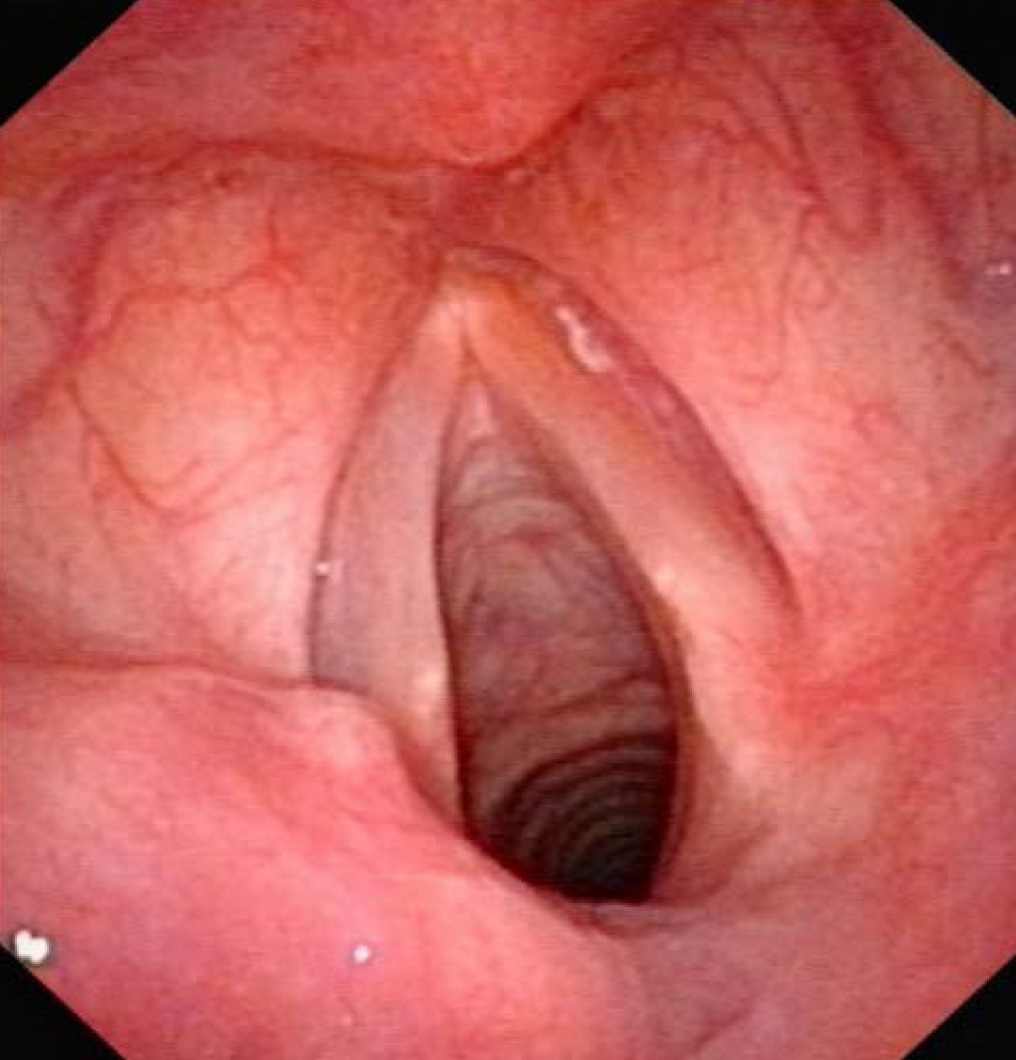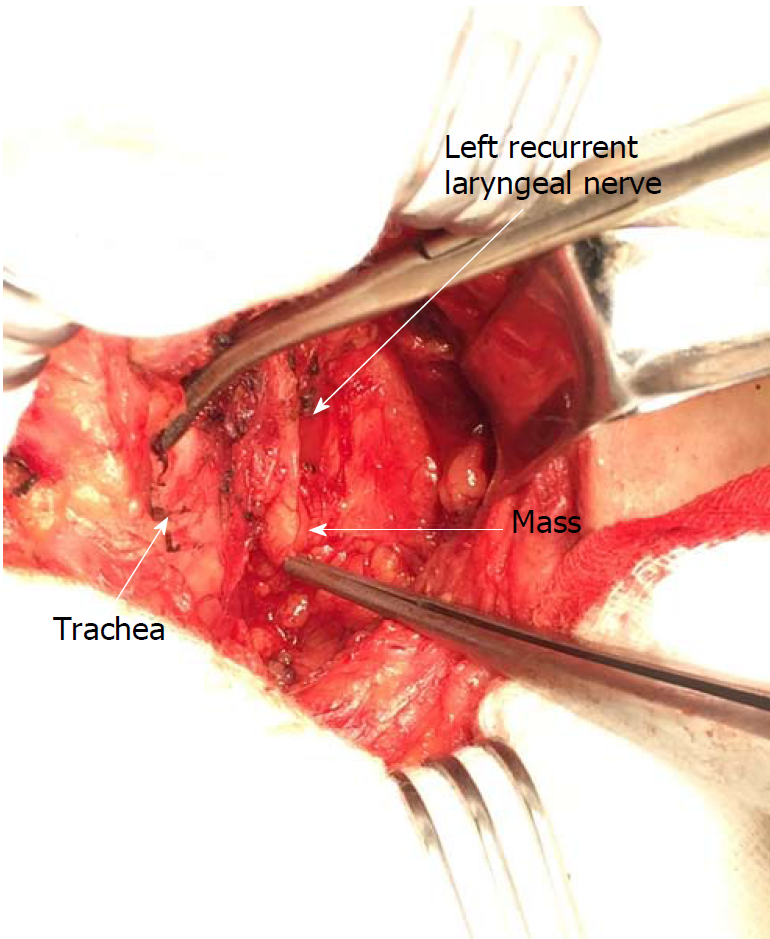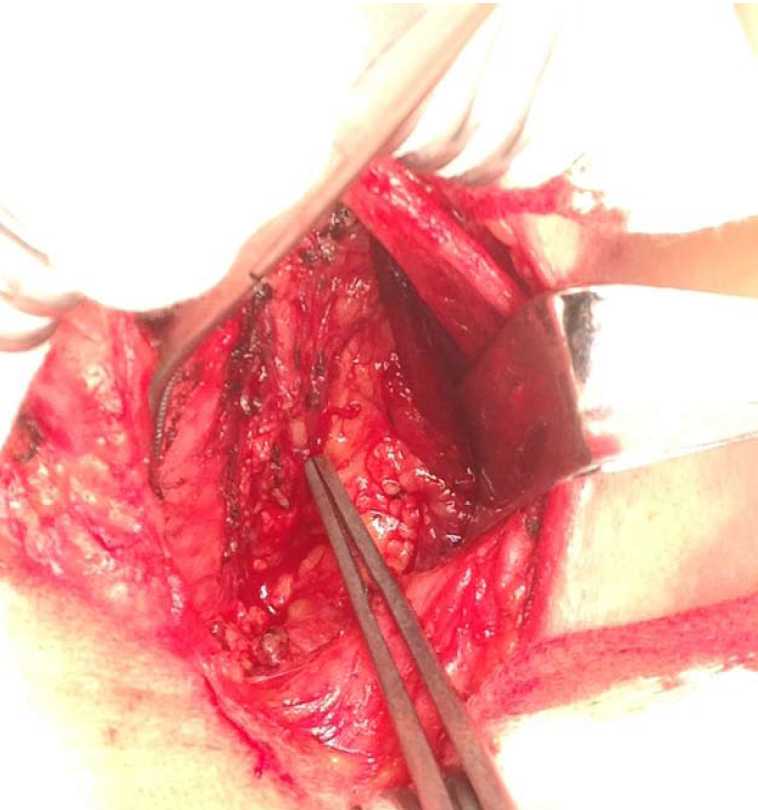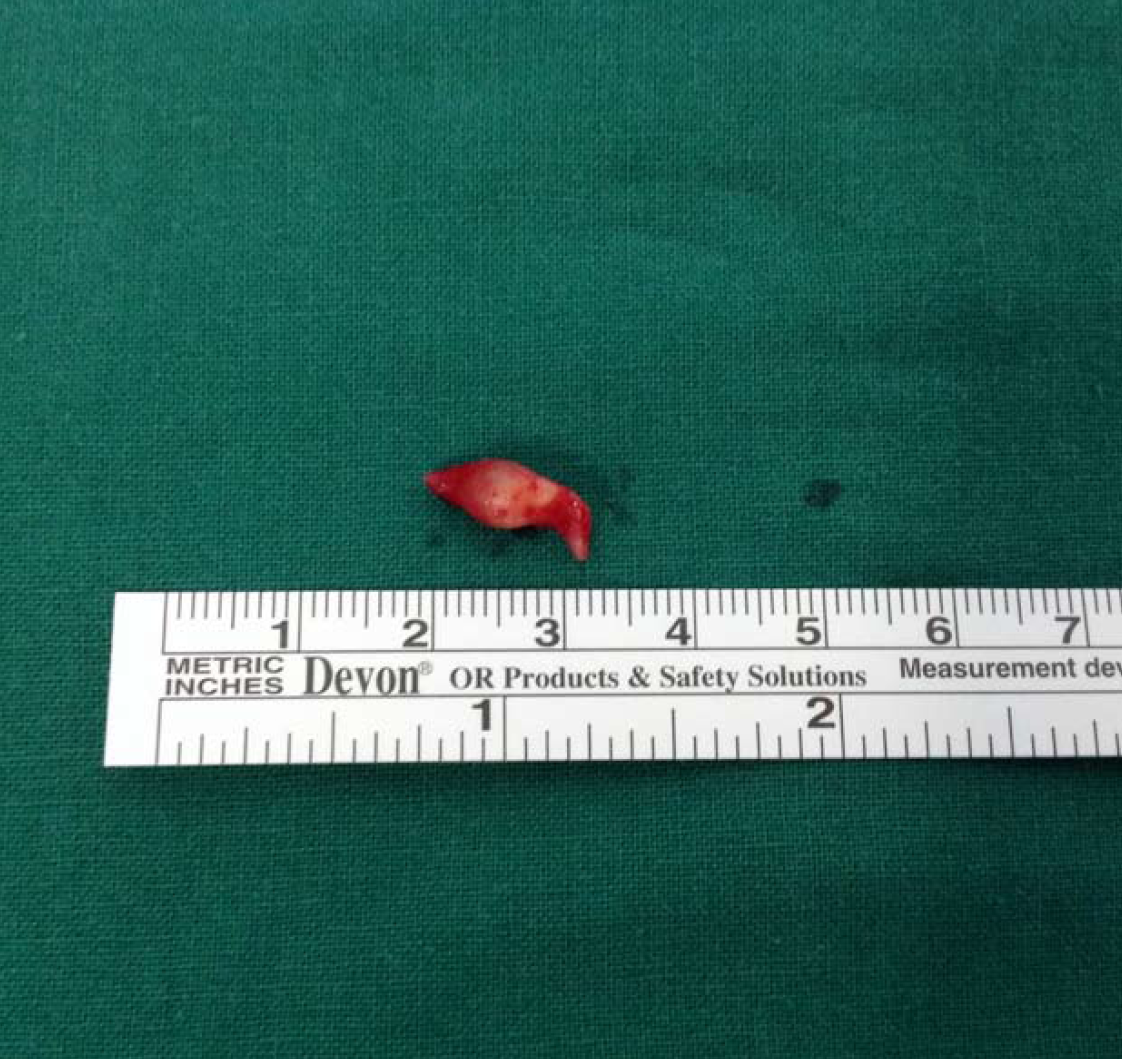Published online Dec 26, 2018. doi: 10.12998/wjcc.v6.i16.1202
Peer-review started: September 21, 2018
First decision: October 25, 2018
Revised: November 5, 2018
Accepted: November 7, 2018
Article in press: November 7, 2018
Published online: December 26, 2018
Processing time: 96 Days and 16.6 Hours
Schwannoma rarely originates from the recurrent laryngeal nerve, and there are few reports on schwannoma originating from the recurrent nerve in the mediastinum. Herein, we present an extremely rare case of schwannoma originating from the recurrent laryngeal nerve in the neck.
This is a case report of one patient diagnosed with thyroid cancer with schwannoma originating from the recurrent laryngeal nerve in the neck, which was incidentally found during a thyroidectomy, and a review of the literature.
Preoperative diagnostic examinations are of less use for detecting schwannoma originating from a recurrent laryngeal nerve in the neck in such small size, which may only incidentally be found during a thyroidectomy. Surgical excision with opening the capsule and shelling out the tumor is the treatment of choice. If the nerve is unable to be preserved, end-to-end recurrent laryngeal nerve anastomosis may be a simple and minimally invasive reconstruction procedure to improve phonation.
Core tip: Schwannoma originating from the left recurrent laryngeal nerve is very rare. This paper showed the clinical manifestation and management of such a case, and a systematic literature review was also performed. This case has very useful clinical practice meanings for residents and medical students, including physicians and surgeons. Surgical excision with opening the capsule and shelling out the tumor is the treatment of choice. If the nerve is not able to be preserved, end-to-end recurrent laryngeal nerve anastomosis may be a simple and minimally invasive reconstruction procedure to improve phonation.
- Citation: Xu XQ, Hong T, Zheng CJ. Schwannoma originating from the recurrent laryngeal nerve in a thyroid cancer patient: A case report and review of the literature. World J Clin Cases 2018; 6(16): 1202-1205
- URL: https://www.wjgnet.com/2307-8960/full/v6/i16/1202.htm
- DOI: https://dx.doi.org/10.12998/wjcc.v6.i16.1202
Schwannoma is a rare tumor originating from any peripheral nerve or nerve root sheath, mostly in the head, neck, or extremities, which can occur as isolated or multiple lesions[1]. These tumors are difficult to be diagnosed preoperatively as they may present at a multitude of sites and mimic a multitude of other neck lesions. Schwannoma rarely originates from the recurrent laryngeal nerve, and there are only few reports on schwannoma originating from the recurrent nerve in the mediastinum. The rarity and unremarkable symptoms of these tumors often result in a difficult preoperative diagnosis. Herein, we present an extremely rare case of schwannoma originating from the recurrent laryngeal nerve in the neck.
Suspected thyroid cancer found by routine health screening ultrasound with hoarseness for one year.
A 61-year-old man was referred to our hospital due to suspected thyroid cancer found by routine health screening ultrasound with hoarseness for one year.
None specific.
Unremarkable.
The laboratory data confirmed normal thyroid and parathyroid function.
Thyroid ultrasound showed a solitary nodule with hypoechogenicity, irregular borders, and microcalcifications about 0.6 cm × 0.6 cm in the left thyroid lobe. Preoperative laryngoscopy revealed limited motion and low tension of the left vocal cord (Figure 1), which was suspected to be paralysis of the left recurrent laryngeal nerve caused by tumor invasion.
The patient underwent thyroid nodule resection, and intraoperative frozen-section examination confirmed the diagnosis of thyroid papillary carcinoma. Thus, a total thyroidectomy with prophylactic ipsilateral central compartment lymph node dissection was performed. While dissecting the left recurrent laryngeal nerve, a mass originating from the left recurrent laryngeal nerve was found (Figure 2). Enucleation of the mass was tried, but the capsule could not be dissected from the nerve, so the mass was resected along the nerve, and the left recurrent laryngeal nerve was end-to-end anastomosed with 7-0 proline (Figure 3).
The resected tumor was a well-encapsulated solid mass measuring about 1.0 cm × 0.5 cm (Figure 4). The pathological results revealed an ancient type of schwannoma with a fibrous capsule, which showed nuclear palisading and hyaline growth of spindle cells. Immunohistochemistry assay demonstrated that the tumor cells were positive for S100. The final diagnosis was a benign neurilemoma originating from the left recurrent laryngeal nerve.
The postoperative recovery for the patient was uneventful, and his phonation reported by himself was improved one week later compared with that before the surgery.
Schwannomas are benign nerve sheath tumors of Schwann cell origin arising from nerves covered with a neurilemmal sheath. The tumor is usually solitary and can arise from any cranial or peripheral nerve, which is also called neurinoma, peripheral glioma, peripheral fibroblastoma, schwannoma, and neurilemmoma. About 25%-40% of cases occur in head and neck region[1]. Schwannoma rarely originates from the recurrent laryngeal nerve, and there are few reports on schwannoma originating from the recurrent laryngeal nerve in the mediastinum[2-4]. To the best of our knowledge, ancient schwannoma of the left recurrent laryngeal nerve found incidentally in a thyroidectomy with such small size has not been reported in the literature.
Imaging modalities such as ultrasound, computed tomography (CT), and magnetic resonance imaging (MRI) are often used to differentiate the lesions in the neck and to investigate the anatomical relationship between the lesions and the surrounding tissues. The most common ultrasound feature of a schwannoma is a well-defined, hypoechoic, homogeneous nodule without an echoic hilum. The nerve from which the tumor originates may seem to be stretched over the capsule, while the nerve fibers themselves may be thickened around the mass. The suspected diagnosis would not be made in most cases before ultrasound imaging and they may often mimic an enlarged or metastasized lymph node in the neck[5]. Razek et al[6] showed that diffusion-weighted MRI may be used for differentiation of schwannoma and lymph node. MRI is capable of reliably imaging not only the tumor and its capsule but also the nerve from which the tumor arises.
But usually, preoperative diagnostic examinations are of less use for detecting schwannoma originating from the recurrent laryngeal nerve in such small size, which may only incidentally be found during a thyroidectomy like this case. Generally, schwannoma originating from the recurrent laryngeal nerve may first mimic a thyroid mass or lymph node. Therefore, resection is necessary, both to remove the tumor and for diagnosis. If enucleation is possible by opening the capsule and shelling out the tumor, functional preservation of the nerve might be achieved. However, in most cases as seen here, complete tumor excision with end-to-end nerve anastomosis may be the only feasible option[1]. Unfortunately, if the nerve is not able to be preserved, end-to-end recurrent laryngeal nerve anastomosis may be a simple and minimally invasive reconstruction procedure to improve phonation. Although the reinnervated vocal cord did not regain normal movement, phonation was remarkably improved. Surgical reinnervation has been proved to be effective in restoring neural function to laryngeal muscles, which could prevent atrophy of laryngeal muscles, improve the bulk and position of vocal folds, and enhance overall vocal quality[7].
In conclusion, in cases of small thyroid nodules with unexplained preoperative vocal palsy, a co-existent pathology such as schwannoma of the recurrent laryngeal nerve may be suspected. Surgical excision with opening the capsule and shelling out the tumor is the treatment of choice. If the nerve is not able to be preserved, end-to-end recurrent laryngeal nerve anastomosis may be a simple and minimally invasive reconstruction procedure to improve phonation.
Schwannomas originating from the recurrent laryngeal nerve are difficult to be diagnosed preoperatively as they may present at a multitude of sites and mimic a multitude of other neck lesions. Surgical excision with opening the capsule and shelling out the tumor is the treatment of choice. If the nerve was not able to be preserved, end-to-end recurrent laryngeal nerve anastomosis may be a simple and minimally invasive reconstruction procedure. The reconstruction via recurrent laryngeal nerve anastomosis may improve phonation.
Conflict of interest statement: The authors have no conflict of interest to declare.
Manuscript source: Unsolicited manuscript
Specialty type: Medicine, research and experimental
Country of origin: China
Peer-review report classification
Grade A (Excellent): 0
Grade B (Very good): 0
Grade C (Good): C, C, C
Grade D (Fair): D
Grade E (Poor): 0
P- Reviewer: Akbulut S, Dhiwakar M, Noussios GI, Razek AAKA S- Editor: Ji FF L- Editor: Wang TQ E- Editor: Wu YXJ
| 1. | Pillai S, Agarwal AC, Mathew M, Nayak DR. Ancient schwannoma mimicking a thyroid mass with retrosternal extension. BMJ Case Rep. 2013;2013:pii: bcr2013200608. [RCA] [PubMed] [DOI] [Full Text] [Cited by in Crossref: 4] [Cited by in RCA: 5] [Article Influence: 0.4] [Reference Citation Analysis (0)] |
| 2. | Sasaki K, Kohno T, Mun M, Yoshiya T. Thoracoscopic removal of middle mediastinal schwannoma originating from recurrent nerve. Thorac Cardiovasc Surg. 2008;56:375-377. [RCA] [PubMed] [DOI] [Full Text] [Cited by in Crossref: 12] [Cited by in RCA: 10] [Article Influence: 0.6] [Reference Citation Analysis (0)] |
| 3. | Varaldo E, Crespi G, Ansaldo GL, Borgonovo G, Boccardo F, Torre G. Neurinoma originating from the recurrent nerve: report of a case. Surg Today. 2008;38:633-634. [RCA] [PubMed] [DOI] [Full Text] [Cited by in Crossref: 5] [Cited by in RCA: 6] [Article Influence: 0.4] [Reference Citation Analysis (0)] |
| 4. | Ito T, Komatsu D, Nakata T, Kumaki T, Aoki T, Kasuga Y. Neurilemoma originating from the left recurrent nerve in the superior mediastinum: report of a case. Surg Today. 2004;34:769-771. [RCA] [PubMed] [DOI] [Full Text] [Cited by in Crossref: 2] [Cited by in RCA: 2] [Article Influence: 0.1] [Reference Citation Analysis (0)] |
| 5. | Miyauchi A, Matsusaka K, Kawaguchi H, Nakamoto K, Maeda M. Ansa-recurrent nerve anastomosis for vocal cord paralysis due to mediastinal lesions. Ann Thorac Surg. 1994;57:1020-1021. [RCA] [PubMed] [DOI] [Full Text] [Cited by in Crossref: 15] [Cited by in RCA: 14] [Article Influence: 0.5] [Reference Citation Analysis (0)] |
| 6. | Razek AAKA, Ashmalla GA. Assessment of paraspinal neurogenic tumors with diffusion-weighted MR imaging. Eur Spine J. 2018;27:841-846. [RCA] [PubMed] [DOI] [Full Text] [Cited by in Crossref: 57] [Cited by in RCA: 58] [Article Influence: 7.3] [Reference Citation Analysis (1)] |
| 7. | Miyauchi A, Inoue H, Tomoda C, Fukushima M, Kihara M, Higashiyama T, Takamura Y, Ito Y, Kobayashi K, Miya A. Improvement in phonation after reconstruction of the recurrent laryngeal nerve in patients with thyroid cancer invading the nerve. Surgery. 2009;146:1056-1062. [RCA] [PubMed] [DOI] [Full Text] [Cited by in Crossref: 83] [Cited by in RCA: 65] [Article Influence: 4.1] [Reference Citation Analysis (0)] |












